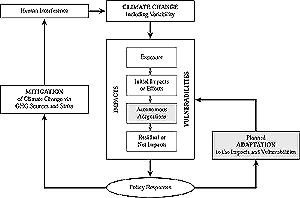18.1. Introduction: Adaptation and Adaptive Capacity
|

Figure 18-1: Places of adapatation in the climate
change issue (Smit et al., 1999).
|
Adaptation is adjustment in ecological, social, or economic systems
in response to actual or expected climatic stimuli and their effects or impacts.
This term refers to changes in processes, practices, or structures to moderate
or offset potential damages or to take advantage of opportunities associated
with changes in climate. It involves adjustments to reduce the vulnerability
of communities, regions, or activities to climatic change and variability. Adaptation
is important in the climate change issue in two ways—one relating to the
assessment of impacts and vulnerabilities, the other to the development and
evaluation of response options.
Understanding expected adaptations is essential to impact and vulnerability
assessment and hence is fundamental to estimating the costs or risks of
climate change (Fankhauser, 1996; Yohe et al., 1996; Tol et al.,
1998; UNEP, 1998; Smit et al., 1999; Pittock and Jones, 2000). Article
2 of the United Nations Framework Convention on Climate Change (UNFCCC) refers
to "dangerous" human influences on climate in terms of whether they
would "allow ecosystems to adapt, ensure food production is not threatened,
and enable economic development to proceed in a sustainable manner." The
extent to which ecosystems, food supplies, and sustainable development are vulnerable
or "in danger" depends on their exposure to climate change effects
and on the ability of impacted systems to adapt. Thus, to assess the dangerousness
of climate change, impact and vulnerability assessments must address the likelihood
of autonomous adaptations (see Figure 18-1).
Adaptation also is considered an important response option or strategy,
along with mitigation (Fankhauser, 1996; Smith, 1996; Pielke, 1998; Kane and
Shogren, 2000). Even with reductions in greenhouse gas (GHG) emissions, global
temperatures are expected to increase, other changes in climate—including
extremes—are likely, and sea level will continue to rise (Raper et al.,
1996; White and Etkin, 1997; Wigley, 1999). Hence, development of planned adaptation
strategies to deal with these risks is regarded as a necessary complement to
mitigation actions (Burton, 1996; Smith et al., 1996; Parry et al.,
1998; Smit et al., 1999) (see Figure 18-1). Article
4.1 of the UNFCCC commits parties to formulating, cooperating on, and implementing
"measures to facilitate adequate adaptation to climate change." The
Kyoto Protocol (Article 10) also commits parties to promote and facilitate adaptation
and deploy adaptation technologies to address climate change.
Adaptive capacity is the potential or ability of a system, region, or
community to adapt to the effects or impacts of climate change. Enhancement
of adaptive capacity represents a practical means of coping with changes and
uncertainties in climate, including variability and extremes. In this way, enhancement
of adaptive capacity reduces vulnerabilities and promotes sustainable development
(Goklany, 1995; Burton, 1997; Cohen et al., 1998; Klein, 1998; Rayner
and Malone, 1998; Munasinghe, 2000; Smit et al., 2000).
Considerable attention has been devoted to the characteristics of communities,
countries, and regions that influence their propensity or ability to adapt and
hence their vulnerability to risks associated with climate change. These determinants
of adaptive capacity relate to the economic, social, institutional, and
technological conditions that facilitate or constrain the development and deployment
of adaptive measures (e.g., Bohle et al., 1994; Rayner and Malone, 1998;
Kelly and Adger, 1999).
|